Prototype Implementation of a Digitizer for Earthquake Monitoring System
Abstract
:1. Introduction
2. Materials and Methods
2.1. System Wiring Diagram
2.2. Casing Mechanical Design
2.3. Data Format
2.4. Data Storage and Streaming
2.5. Decimation Filter
2.6. Graphical User Interface (GUI)
3. Results
3.1. Comparison with Calibrated Digitizer
3.2. Integration with ENSN Stations
3.2.1. Case Study #1
3.2.2. Case Study #2
4. Discussion and Conclusions
Author Contributions
Funding
Institutional Review Board Statement
Informed Consent Statement
Data Availability Statement
Acknowledgments
Conflicts of Interest
Abbreviations
| ADC | Analog-to-digital converter |
| SEED | Standard for the exchange of earthquake data |
| GNSS | Global navigation satellite system |
| TCP/IP | Transmission control protocol/internet protocol |
| FIR Finite | Impulse response |
| SBC | Single-board computer |
| ENSN | Egyptian National Seismic Network |
References
- Schaumann, M.; Gamba, D.; Garcia Morales, H.; Corsini, R.; Guinchard, M.; Scislo, L.; Wenninger, J. The Effect of Ground Motion on the LHC and HL-LHC Beam Orbit. Nucl. Instrum. Methods Phys. Res. Sect. A 2023, 1055, 168495. [Google Scholar] [CrossRef]
- Ścisło, Ł.; Łacny, Ł.; Guinchard, M. COVID-19 Lockdown Impact on CERN Seismic Station Ambient Noise Levels. Open Eng. 2022, 12, 62–69. [Google Scholar] [CrossRef]
- Bath, M. Introduction to Seismology; John Wiley & Sons, Incorporated: Hoboken, NJ, USA, 1978; ISBN 9780470991282. [Google Scholar]
- Shearer, P.M. Introduction to Seismology, 2nd ed.; Cambridge University Press: Cambridge, UK, 2009. [Google Scholar]
- Song, K.; Cao, G.; Yang, J.; Cao, P. A High-Precision Synchronous Sampling Approach for Large-Scale Distributed Wire Sensor Networks in Seismic Data Acquisition Systems. Instrum. Sci. Technol. 2012, 40, 567–579. [Google Scholar] [CrossRef]
- Home|Nanometrics. Available online: https://www.nanometrics.ca/ (accessed on 14 August 2022).
- Kinemetrics. Available online: https://kinemetrics.com/ (accessed on 14 August 2022).
- REF TEK Systems Inc. Seismic Monitoring Systems. Available online: https://reftek.com/ (accessed on 14 August 2022).
- ION. Available online: https://www.iongeo.com/ (accessed on 14 August 2022).
- Sercel—Seismic Acquisition Systems. Available online: https://www.sercel.com/Pages/default.aspx (accessed on 14 August 2022).
- Zhao, X.; Zhang, Q.; Deng, M. Super Class-AB Bulk-driven OTAs with Improved Slew Rate. Electron. Lett. 2015, 51, 1488–1489. [Google Scholar] [CrossRef]
- Liang, G.; Li, W. Some Thoughts and Practice on Performance Improvement in Distributed Control System Based on Fieldbus and Ethernet. Meas. Control 2016, 49, 109–118. [Google Scholar] [CrossRef]
- Helal, E.; Khattab, A.; Fahmy, Y.A. Energy-Efficient Cluster Head Selection for Cognitive Radio Sensor Networks. In Proceedings of the 2016 28th International Conference on Microelectronics (ICM), Giza, Egypt, 17–20 December 2016; pp. 205–208. [Google Scholar]
- Zambrano, A.M.; Perez, I.; Palau, C.; Esteve, M. Technologies of Internet of Things Applied to an Earthquake Early Warning System. Futur. Gener. Comput. Syst. 2017, 75, 206–215. [Google Scholar] [CrossRef]
- Saad, O.M.; Hafez, A.G.; Soliman, M.S. Deep Learning Approach for Earthquake Parameters Classification in Earthquake Early Warning System. IEEE Geosci. Remote Sens. Lett. 2020, 18, 1293–1297. [Google Scholar] [CrossRef]
- Helal, E.B.; Saad, O.M.; Hafez, A.G.; Chen, Y.; Dousoky, G.M. Seismic Data Compression Using Deep Learning. IEEE Access 2021, 9, 58161–58169. [Google Scholar] [CrossRef]
- Zhang, Q.; Deng, M.; Cui, J.; Wang, Q. Research and Development of One Novel Distributed Digital Seismic Acquisition Station. Adv. Inf. Sci. Serv. Sci. 2012, 4, 184–190. [Google Scholar]
- Guo, F.; Zhang, Q.; Zhang, Q.; Li, W.; Luo, Y.; Niu, Y.; Qiao, S. Development of a New Centralized Data Acquisition System for Seismic Exploration. Geosci. Instrum. Methods Data Syst. 2020, 9, 255–266. [Google Scholar] [CrossRef]
- Ramdeane, A.; Lynch, L. Low Cost Seismic Data Acquisition System Based on Open Source Hardware and Software Tools. Ph.D. Thesis, Faculty of Engineering, The University of the West Indies, Kingston, Jamaica, 2020; pp. 496–505. [Google Scholar]
- Daryono, L.R.; Rahmadi, A.; Suyanto, I.; Suryanto, W. Design and Implementation of Seismic Data Acquisition System Using PC/104. SN Appl. Sci. 2019, 1, 1182. [Google Scholar] [CrossRef]
- Li, M.; Yuan, Z.; Jiang, C. Design of Seismic Data Acquisition System. In Proceedings of the IEEE 10th International Conference on Signal Processing Proceedings, ICSP, Beijing, China, 24–28 October 2010; pp. 2580–2583. [Google Scholar]
- Qiao, S.; Zhang, Q.; Zhang, Q. Mine Fracturing Monitoring Analysis Based on High-Precision Distributed Wireless Microseismic Acquisition Station. IEEE Access 2019, 7, 147215–147223. [Google Scholar] [CrossRef]
- Attia, H.; Gaya, S.; Alamoudi, A.; Alshehri, F.M.; Al-Suhaimi, A.; Alsulaim, N.; Al Naser, A.M.; Aghyad Jamal Eddin, M.; Alqahtani, A.M.; Prieto Rojas, J.; et al. Wireless Geophone Sensing System for Real-Time Seismic Data Acquisition. IEEE Access 2020, 8, 81116–81128. [Google Scholar] [CrossRef]
- Jornet-Monteverde, J.A.; Galiana-Merino, J.J.; Soler-Llorens, J.L. Design and Implementation of a Wireless Sensor Network for Seismic Monitoring of Buildings. Sensors 2021, 21, 3875. [Google Scholar] [CrossRef] [PubMed]
- Huang, Y.; Song, J.; Mo, W.; Dong, K.; Wu, X.; Peng, J.; Jin, F. A Seismic Data Acquisition System Based on Wireless Network Transmission. Sensors 2021, 21, 4308. [Google Scholar] [CrossRef] [PubMed]
- Karakostas, C.Z.; Papanikolaou, V.K. A Low-Cost Instrumentation Approach for Seismic Hazard Assessment in Urban Areas. In Risk Analysis IX; WIT Transactions on Information and Communication Technologies; WIT Press: Southampton, UK, 2014; Volume 47, pp. 97–107. [Google Scholar]
- Soler-Llorens, J.L.; Galiana-Merino, J.J.; Giner-Caturla, J.; Jauregui-Eslava, P.; Rosa-Cintas, S.; Rosa-Herranz, J. Development and Programming of Geophonino: A Low Cost Arduino-Based Seismic Recorder for Vertical Geophones. Comput. Geosci. 2016, 94, 1–10. [Google Scholar] [CrossRef]
- Anthony, R.E.; Ringler, A.T.; Wilson, D.C.; Wolin, E. Do Low-cost Seismographs Perform Well Enough for Your Network? An Overview of Laboratory Tests and Field Observations of the OSOP Raspberry Shake 4D. Seismol. Res. Lett. 2019, 90, 219–228. [Google Scholar] [CrossRef]
- Soler-Llorens, J.L.; Galiana-Merino, J.J.; Giner-Caturla, J.J.; Jauregui-Eslava, P.; Rosa-Cintas, S.; Rosa-Herranz, J.; Nassim Benabdeloued, B.Y. Design and Test of Geophonino-3D: A Low-Cost Three-Component Seismic Noise Recorder for the Application of the H/V Method. Sens. Actuators A Phys. 2018, 269, 342–354. [Google Scholar] [CrossRef]
- Holmgren, J.M.; Werner, M.J. Raspberry Shake Instruments Provide Initial Ground-motion Assessment of the Induced Seismicity at the United Downs Deep Geothermal Power Project in Cornwall, United Kingdom. Seism. Rec. 2021, 1, 27–34. [Google Scholar] [CrossRef]
- Calais, E.; Boisson, D.; Symithe, S.; Momplaisir, R.; Prépetit, C.; Ulysse, S.; Etienne, G.P.; Courboulex, F.; Deschamps, A.; Monfret, T.; et al. Monitoring Haiti’s Quakes with Raspberry Shake. Eos 2019, 100. [Google Scholar] [CrossRef]
- Bravo-Haro, M.A.; Ding, X.; Elghazouli, A.Y. MEMS-Based Low-Cost and Open-Source Accelerograph for Earthquake Strong-Motion. Eng. Struct. 2021, 230, 111675. [Google Scholar] [CrossRef]
- Allen, R.M.; Melgar, D. Earthquake Early Warning: Advances, Scientific Challenges, and Societal Needs. Annu. Rev. Earth Planet. Sci. 2019, 47, 361–388. [Google Scholar] [CrossRef]
- Prasanna, R.; Chandrakumar, C.; Nandana, R.; Holden, C.; Punchihewa, A.; Becker, J.S.; Jeong, S.; Liyanage, N.; Ravishan, D.; Sampath, R.; et al. “Saving Precious Seconds”—A Novel Approach to Implementing a Low-Cost Earthquake Early Warning System with Node-Level Detection and Alert Generation. Informatics 2022, 9, 25. [Google Scholar] [CrossRef]
- Clayton, R.W.; Heaton, T.; Kohler, M.; Chandy, M.; Guy, R.; Bunn, J. Community Seismic Network: A Dense Array to Sense Earthquake Strong Motion. Seismol. Res. Lett. 2015, 86, 1354–1363. [Google Scholar] [CrossRef]
- Peng, C.; Jiang, P.; Chen, Q.; Ma, Q.; Yang, J. Performance Evaluation of a Dense MEMS-Based Seismic Sensor Array Deployed in the Sichuan-Yunnan Border Region for Earthquake Early Warning. Micromachines 2019, 10, 735. [Google Scholar] [CrossRef] [PubMed]
- The Project—Earthquake-TURNkey. Available online: https://earthquake-turnkey.eu/the-project/ (accessed on 5 September 2023).
- Pisco, M.; Bruno, F.A.; Galluzzo, D.; Nardone, L.; Gruca, G.; Rijnveld, N.; Bianco, F.; Cutolo, A.; Cusano, A. Opto-Mechanical Lab-on-Fibre Seismic Sensors Detected the Norcia Earthquake. Sci. Rep. 2018, 8, 6680. [Google Scholar] [CrossRef] [PubMed]
- Trillium Compact|Nanometrics. Available online: https://www.nanometrics.ca/products/seismometers/trillium-compact (accessed on 20 September 2022).
- Archived: NI USB-9229/9239 User Guide and Specifications (April 1994)—NI. Available online: https://www.ni.com/docs/en-US/bundle/372409a/page/download.html# (accessed on 22 October 2022).
- C099-F9P Application Board|u-Blox. Available online: https://www.u-blox.com/en/product/c099-f9p-application-board (accessed on 23 July 2022).
- ZED-F9P u-Blox F9 High Precision GNSS Module Data Sheet. Available online: https://cdn.sparkfun.com/assets/d/e/2/8/b/ZED-F9P_datasheet.pdf (accessed on 23 November 2022).
- IW32-3.5″ X86 Embedded Board-Winmate. Available online: https://www.ttx.ca/Product/IW32 (accessed on 23 July 2022).
- Beyreuther, M.; Barsch, R.; Krischer, L.; Megies, T.; Behr, Y.; Wassermann, J. ObsPy: A Python Toolbox for Seismology. Seismol. Res. Lett. 2010, 81, 530–533. [Google Scholar] [CrossRef]
- Centaur Digital Recorder|Nanometrics. Available online: https://www.nanometrics.ca/products/digitizers/centaur-digital-recorder (accessed on 20 September 2022).



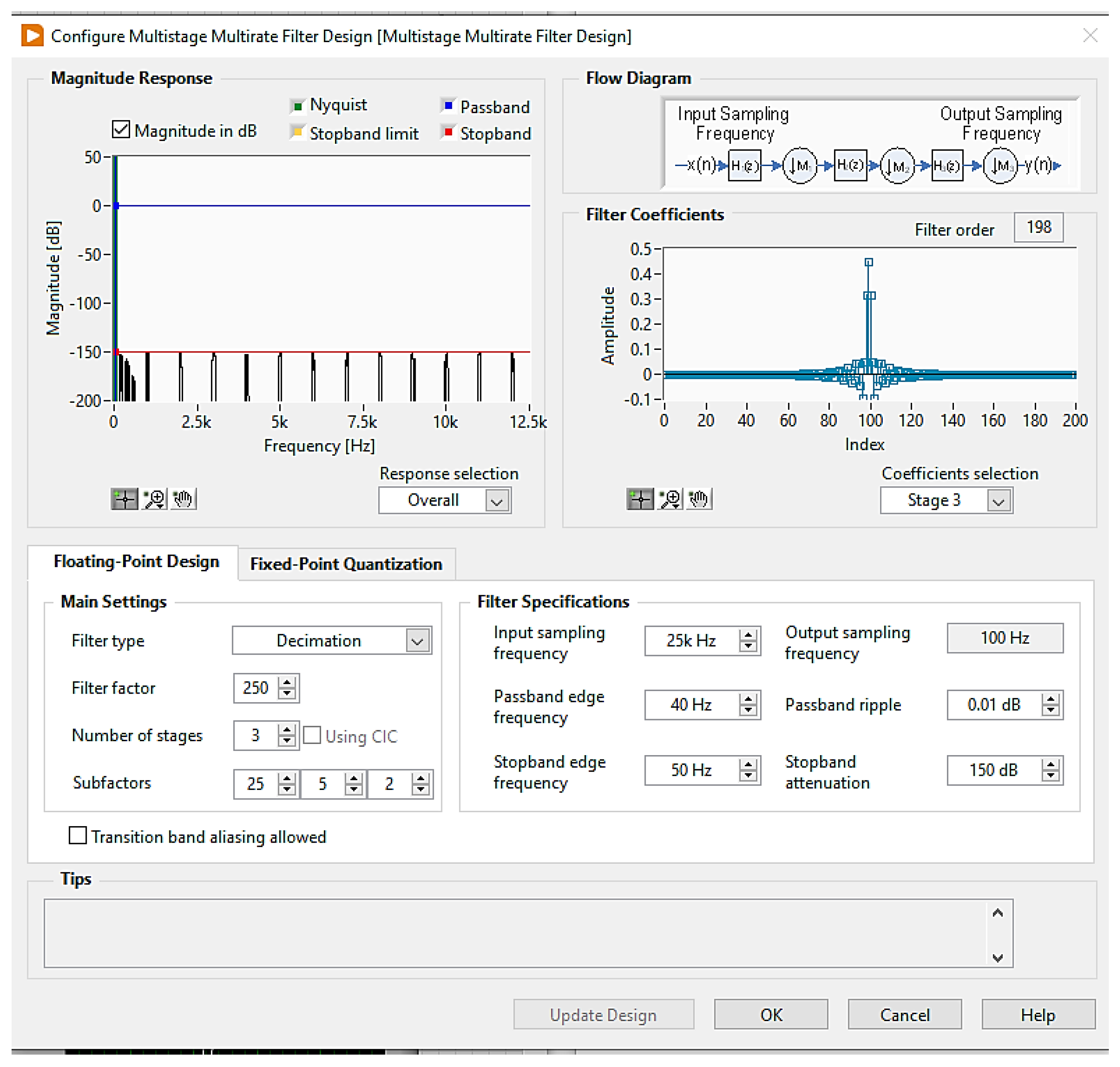
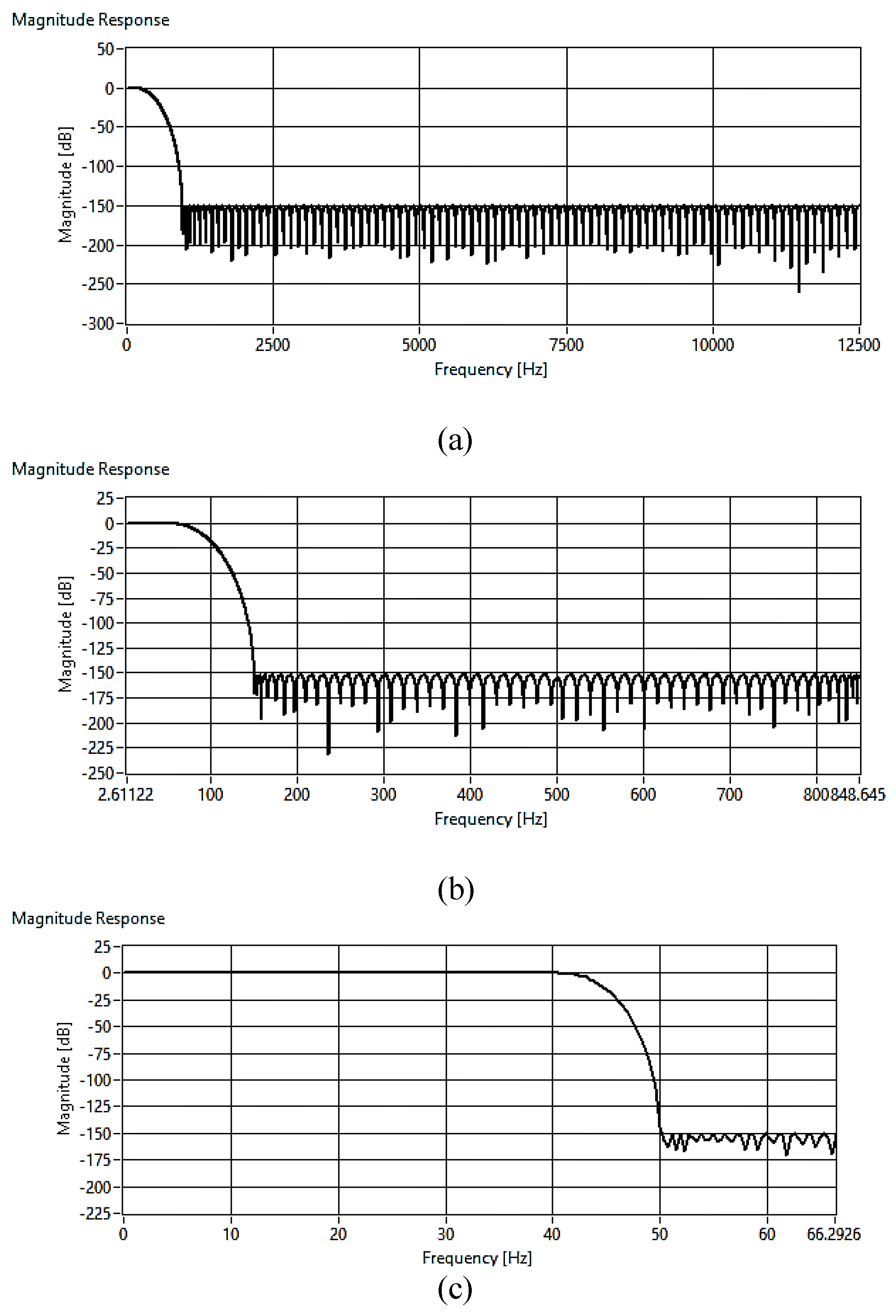




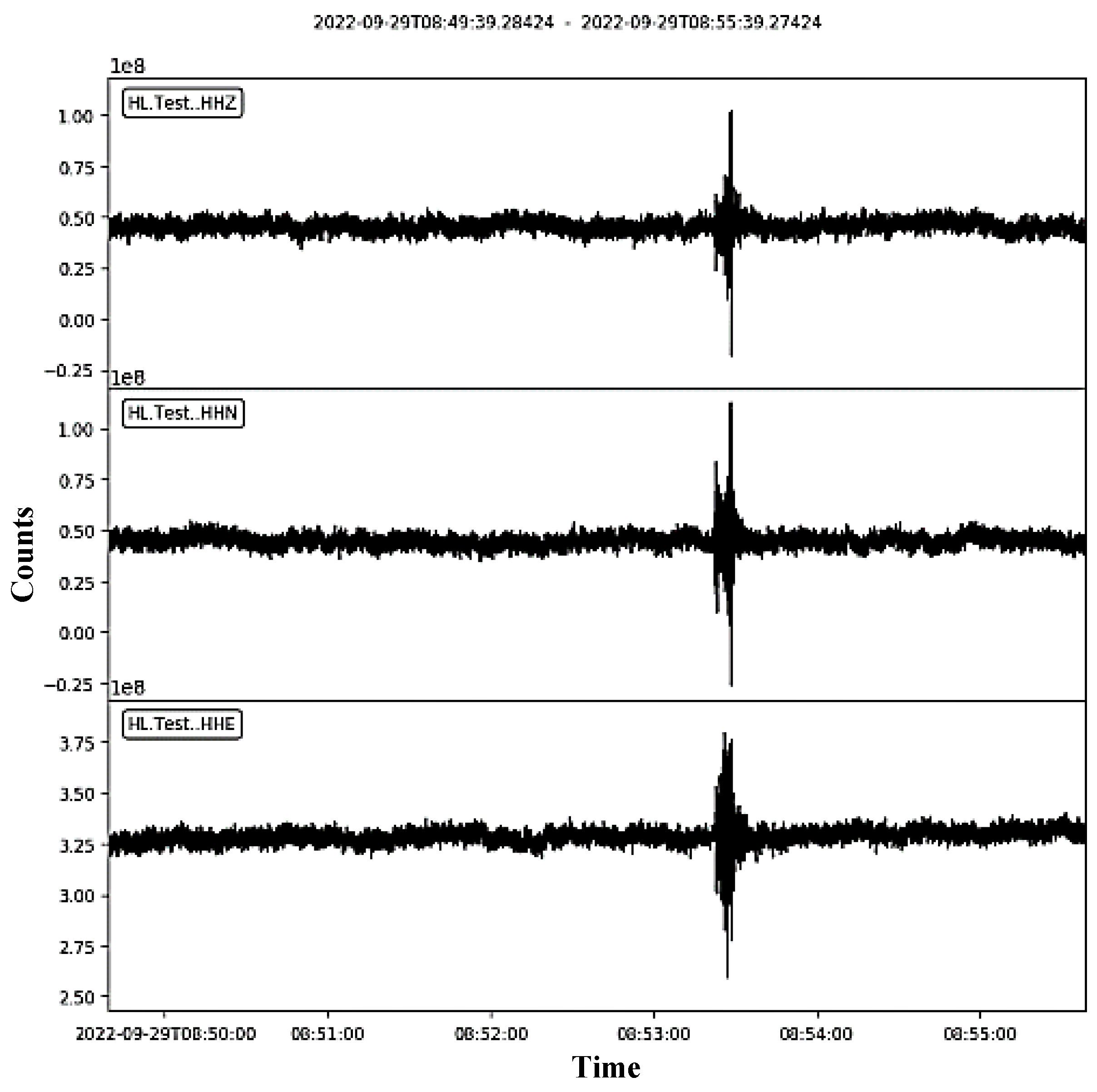
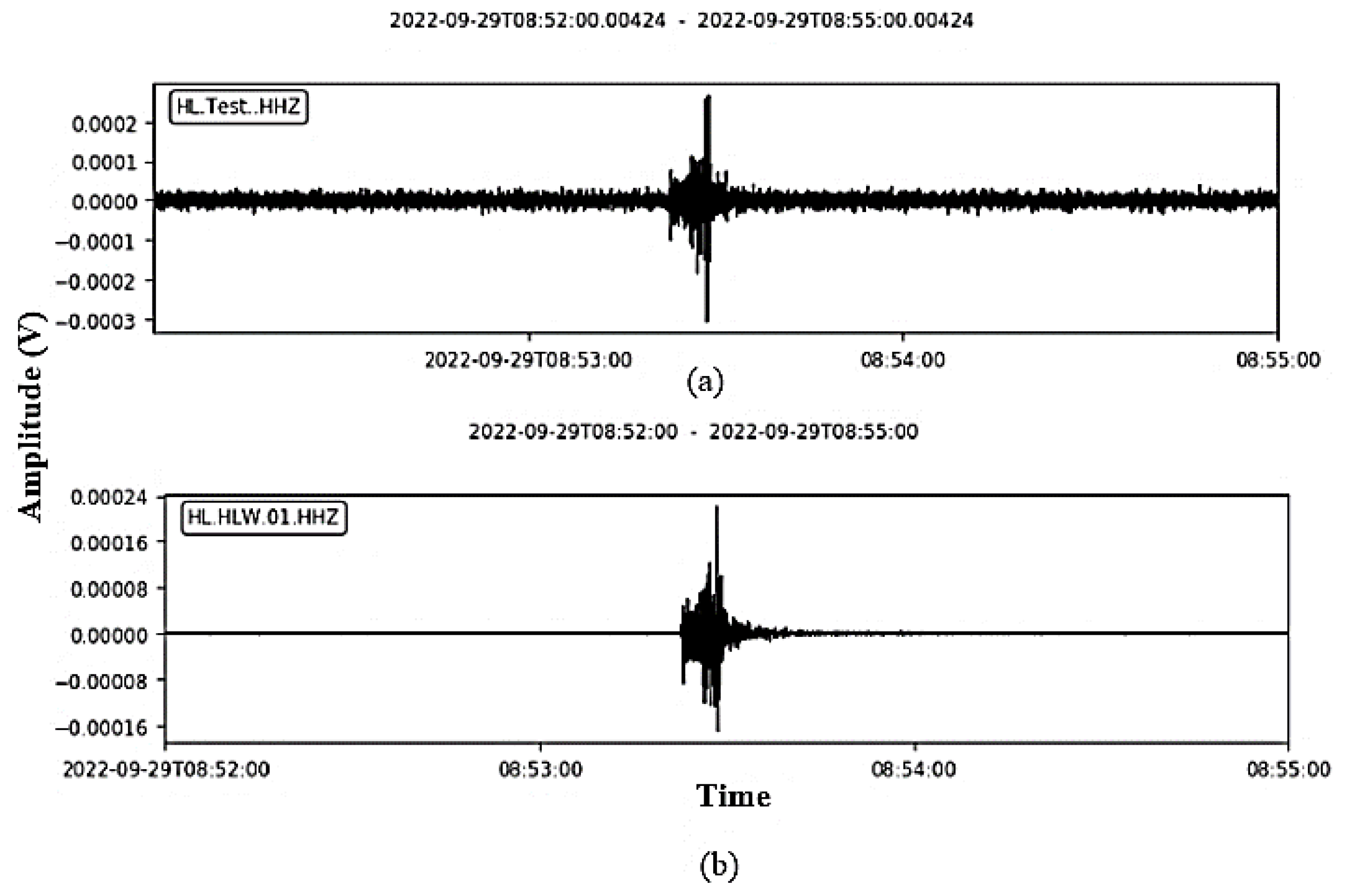


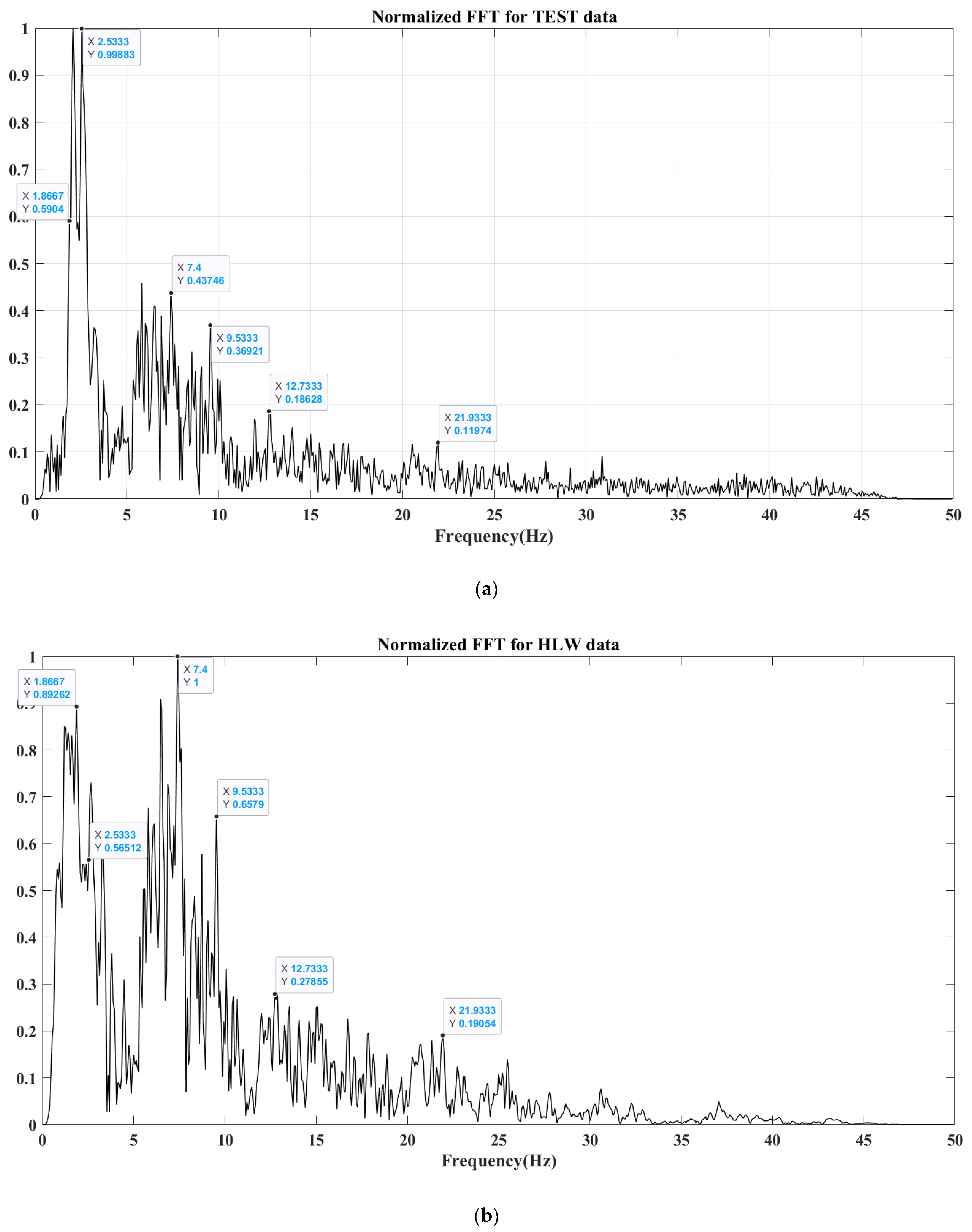
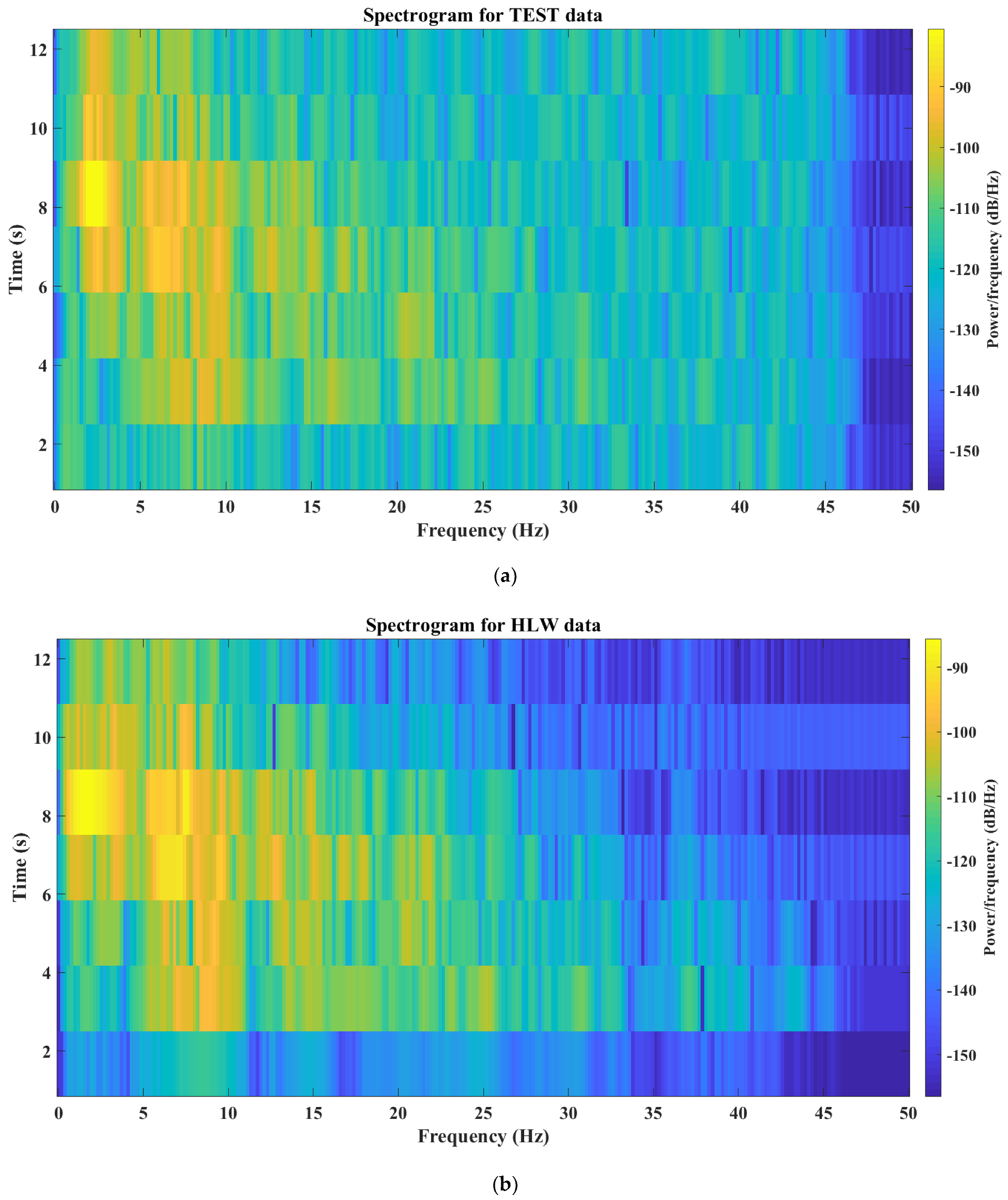

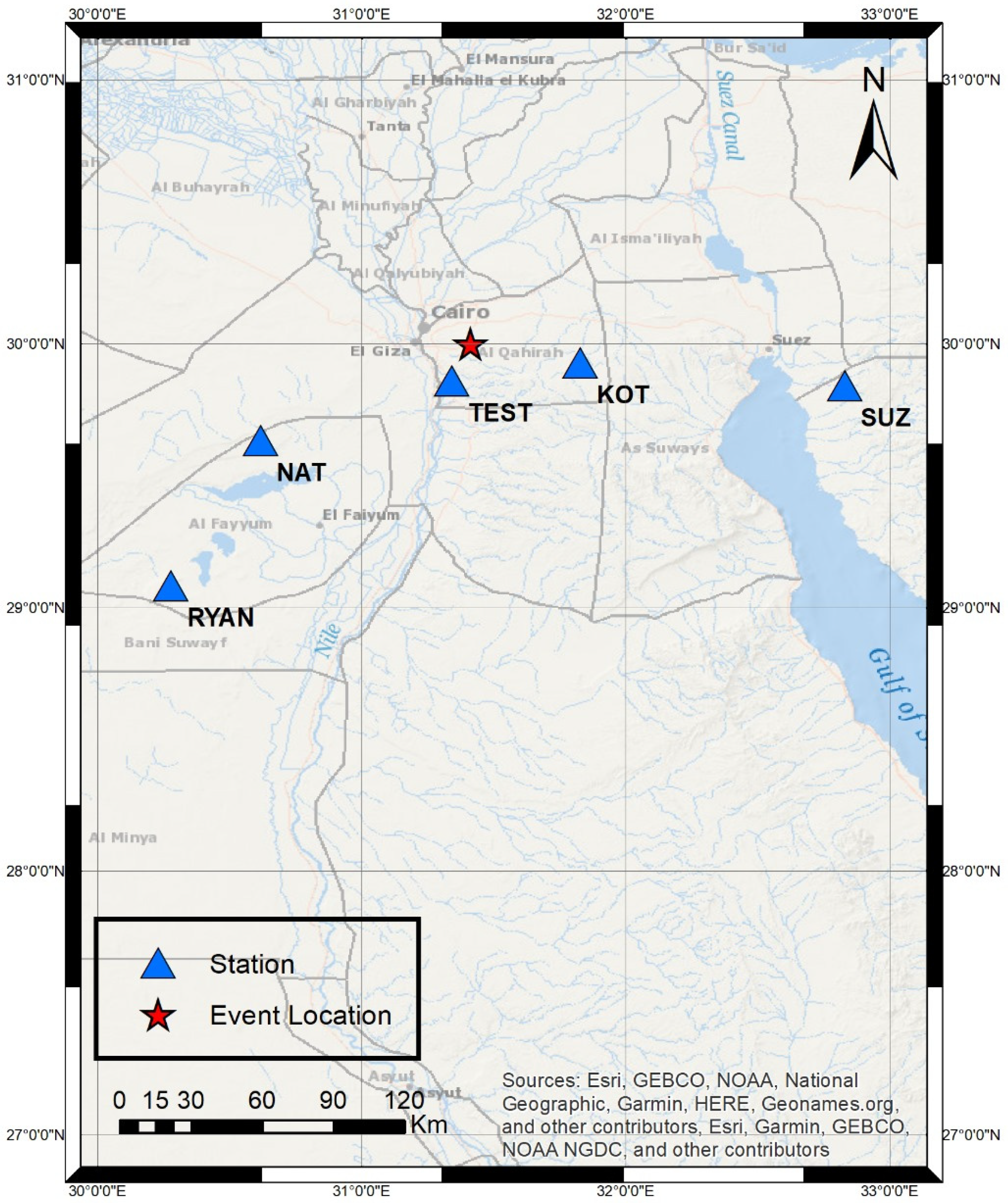
| Case Study #1 | Date | Time (GMT) | Location | Depth (km) | RMS (s) | Amplitude Magnitude | Phases Used | Nearest Station (km) | ||
|---|---|---|---|---|---|---|---|---|---|---|
| LAT | LON | P | S | |||||||
| Without TEST St. | 11 September 2022 | 07:35:14.48 | 29.7978 | 31.4566 | 0.01 | 0.02 | 2.09 | 5 | 0 | 26 |
| With TEST St. | 11 September 2022 | 07:35:13.86 | 29.8953 | 31.3855 | 0 | 0.25 | 2.24 | 4 | 0 | 6 |
| Case Study #2 | Date | Time (GMT) | Location | Depth (km) | RMS (s) | Amplitude Magnitude | Phases Used | Nearest Station (km) | ||
|---|---|---|---|---|---|---|---|---|---|---|
| LAT | LON | P | S | |||||||
| Without TEST St. | 29 September 2022 | 09:00:32.48 | 29.9992 | 31.4123 | 1.69 | 0.00 | 2 | 3 | 1 | 41 |
| With TEST St. | 29 September 2022 | 09:00:32.05 | 29.985 | 31.3997 | 0 | 0.29 | 2.01 | 5 | 1 | 15 |
Disclaimer/Publisher’s Note: The statements, opinions and data contained in all publications are solely those of the individual author(s) and contributor(s) and not of MDPI and/or the editor(s). MDPI and/or the editor(s) disclaim responsibility for any injury to people or property resulting from any ideas, methods, instructions or products referred to in the content. |
© 2024 by the authors. Licensee MDPI, Basel, Switzerland. This article is an open access article distributed under the terms and conditions of the Creative Commons Attribution (CC BY) license (https://creativecommons.org/licenses/by/4.0/).
Share and Cite
Helal, E.B.; Saad, O.M.; Soliman, M.S.; Dousoky, G.M.; Abdelazim, A.; Samy, L.; Kanaya, H.; Hafez, A.G. Prototype Implementation of a Digitizer for Earthquake Monitoring System. Sensors 2024, 24, 5287. https://doi.org/10.3390/s24165287
Helal EB, Saad OM, Soliman MS, Dousoky GM, Abdelazim A, Samy L, Kanaya H, Hafez AG. Prototype Implementation of a Digitizer for Earthquake Monitoring System. Sensors. 2024; 24(16):5287. https://doi.org/10.3390/s24165287
Chicago/Turabian StyleHelal, Emad B., Omar M. Saad, M. Sami Soliman, Gamal M. Dousoky, Ahmed Abdelazim, Lotfy Samy, Haruichi Kanaya, and Ali G. Hafez. 2024. "Prototype Implementation of a Digitizer for Earthquake Monitoring System" Sensors 24, no. 16: 5287. https://doi.org/10.3390/s24165287








